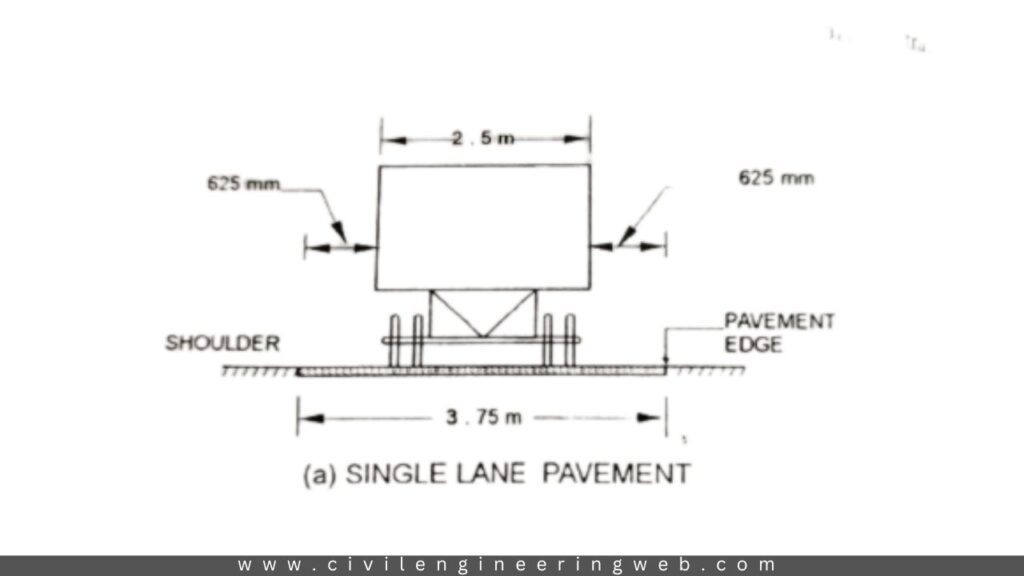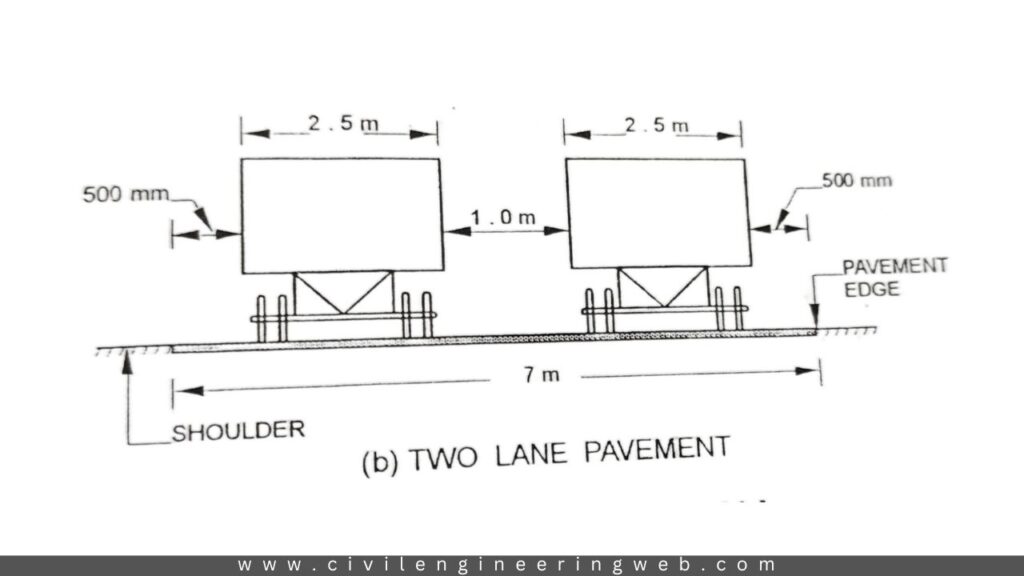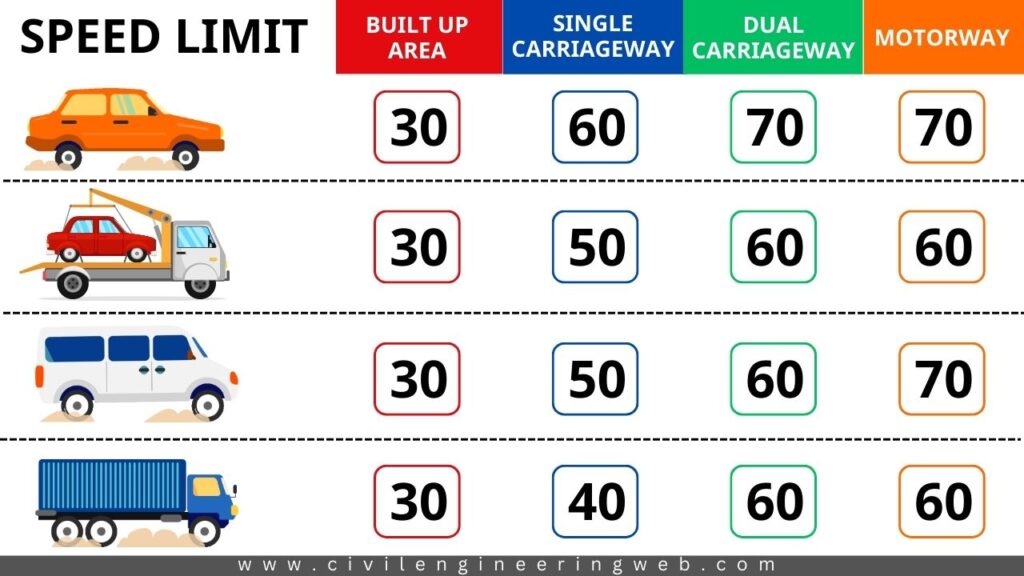In this article, we share the information related to carriageway of road in highways, such as carriageway definition, types and width of carriageway based on various parameters.
So if you get any valuable information from this article and than please share it with your friends.
Table of Contents
What is Carriageway
Carriageway is defined as a portion of road that allows movement of traffic without any disturbance. It is also known as width of pavement. It is consists of multiple traffic lane.

The portion of carriageway that is planned for one line traffic movement is called as a traffic lane. The various lane on carriageway is separated by median strip.
The types and width of carriageway is provided base on purpose, needs, and location. Let’s Discuss about the Width of carriageway.
Also Read: What is Camber in Road
Width of Carriageway
The width of carriageway is depends on width of traffic lane and number of lane provided on carriageway. And, the width of traffic lane is decided based on a standard vehicle such as the passenger car.
However, it is also necessary to consider the maximum width of the largest vehicle class such as the heavy commercial vehicle (HCV) which is legally permitted to use the roadway of country.
The width of lane is such that there is sufficient lateral clearance on either side of the vehicles. And the lateral clearance required is higher in case of high speed vehicle movement.
That’s why, after considering all the factor, a width of 3.5m per lane is generally provided on rural highways in India and 10 to 11 feet in United states ad other countries.
The raised kerb such as footpath is provided on road than the width of lane is increased upto 3.75m. A width of carriage for single lane road is 3.75m in india that is subjected to decrease in low volume road or village road.
The requirement of traffic lanes in highway is depends on predicated traffic volume and desired level of services. The width of carriageway for single lane and two lane is as shown below.
As per IRC, the maximum allowable width of vehicle is 2.5m and the side clearance for single is 625mm on either side of vehicle. After summing these parameters, the desired width of carriageway is 3.75m for single lane traffic. The illustrated figure is shown as below.

And, for two lane, the side clearance on both side is 500mm and in between two vehicles is 1000mm. After summation of these all parameter, the desired width of carriageway come out is 7m for two lane and 3.5m for particular lane. The illustrated figure is shown as below.

Also Read: What is Highway Alignment
Width of carriageway recommended by the IRC
The width of carriageway recommended by the IRC in various condition is tabulated below.
| Sr.no. | Class of Road | Width of Carriageway (m) |
|---|---|---|
| 1 | Single lane road | 3.75 |
| 2 | Two lanes, without raised kerbs | 7.0 |
| 3 | Two lanes, with raised kerbs | 7.5 |
| 4 | Intermediate carriageway (except on important roads) | 5.5 |
| 5 | Multi-lane Pavements | 3.5 per lane |
Notes:
- The lane width of Expressways is 3.75 m in plain and rolling terrains and 3.5 m in mountainous terrain; the change-over of lane width from 3.5 to 3.75 m or 3.75 to 3.5 m should be effected by a smooth transition of 1 in 60 for fatter rate.
- On urban roads without raised kerbs, the lane width may be 3.5 m.
- The minimum width recommended for kerbed urban road is 5.5 m to make allowance for a stalled vehicle.
- In local streets of residential areas the lane width may be decreased to 3.0 m.
The width of carriageway increased on horizontal curves. The IRC recommendation of widening of pavement is tabulated below.
| Radius of curve | Additional Width |
|---|---|
| Upto 40 m | 1.5 m |
| 41 to 60 m | 1.2 m |
| 61-100 m | 0.9 m |
| 101-300 m | 0.6 m |
Also Read: Different Types of Road Patterns
Standard Road Width in Florida
As per Florida department of transportation, the Width of traffic lane is tabulated below.

Note:
- 12 ft. for Design Speeds > 45 mph and for all undivided roadways
- 12 ft.for 2-lane roadways
- With severe R/W controls, 10 ft. turning lanes may be used where design speeds are 40 mph or less and the intersection is controlled by traffic signals. Median turn lanes shall not exceed 15 ft.
- 12 ft. when truck volume exceeds 10%.
- 11 ft. for low volume AADT.
- 11 ft. for divided roadways with Design Speeds ≤ 45 mph within one mile of an urban area.

Note:
- Separated or concurrent flow.
- For Freeway detours, at least one 12 ft. lane must be provided in each direction.
- Urban multi-purpose lanes are usually used as refuge lanes but may be used for loading zones, bus stops, emergency access and other purposes. Parking that adversely impacts capacity or safety is to be eliminated whenever practical. Standard parking width is measured from face of curb, with a minimum width of 8 ft.
- 10 ft. to 12 ft. lanes for commercial and transit vehicles.
- 7 ft. buffered bicycle lane within one mile of an urban area.
Also Read: Classification of Roads in India
Road Width for other Countries
The standard road width for other countries is tabulated below.
| Country | Lane Width (m) |
|---|---|
| United States | 3.30 – 3.60 |
| Brazil | 3.75 |
| Canada | 3.0 – 3.75 |
| Germany | 3.25 – 3.5 |
| Israel | 3.6 |
| Netherlands | 2.75 |
| Sweden | 3.75 |
| United Kingdom | 3.65 |
Also Read: Top 5 Best books for highway engineering
Type of Carriageway
The different types of carriageway is explained as below.
Single Carriageway
Single Carriageway is defined as a road which consisting single or multiple traffic lane with no median strip to separate opposite flow of traffic.
Dual Carriageway
Dual carriageway is defined as a road which consisting two or more traffic lane and separated by median strip to allow two way traffic that means allow traffic travelling in opposite direction.
Carriageway Speed Limit
The speed limit for single and dual carriageway is tabulated below.

| Vehicle | Built Up Area | Single Carriageway | Dual Carriageway | Motorway |
|---|---|---|---|---|
| Cars and Motorcycles | 30 mph | 60 mph | 70 mph | 70 mph |
| Cars Towing caravans or Trailer | 30 mph | 50 mph | 60 mph | 60 mph |
| Buses, Coaches, Mini-buses | 30 mph | 50 mph | 60 mph | 70 mph |
| Goods Vehicles < 7.5 tones | 30 mph | 50 mph | 60 mph | 70 mph |
| Goods Vehicle > 7.5 tones | 30 mph | 40 mph | 60 mph | 60 mph |
References:
- https://www.researchgate.net/figure/The-standard-road-width-in-various-countries-is-shown-in-the-table_tbl1_315847526
- Indian Road Congress
- https://www.fdot.gov/docs/default-source/roadway/bulletin/RDB14-17.pdf
- Highway Engineering by S.K.KHANA & C.EG JUSTO
Join Our Telegram Channel As soon as possible to get such type of information, and have a chance to become first 100 subscriber of our channel.



thanks for your share.